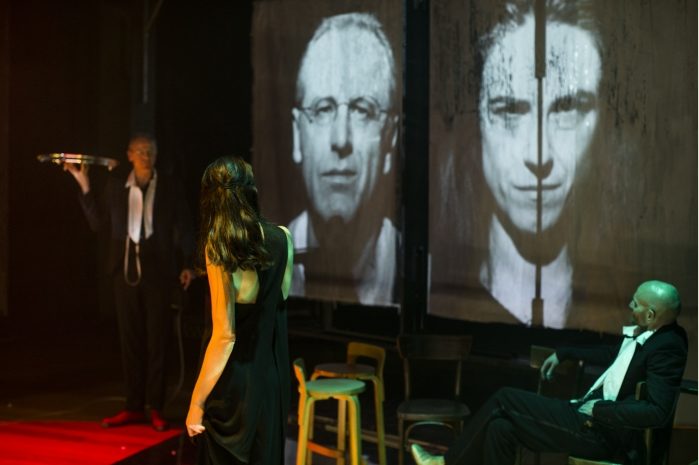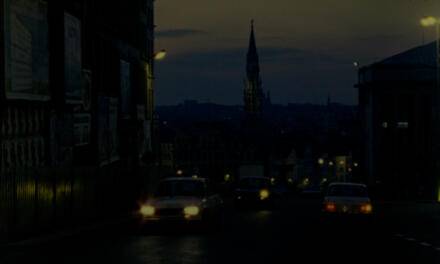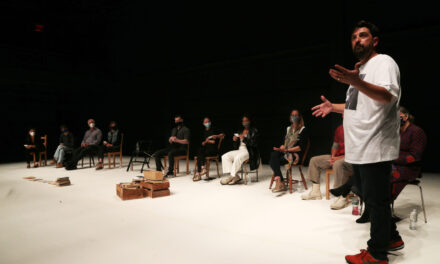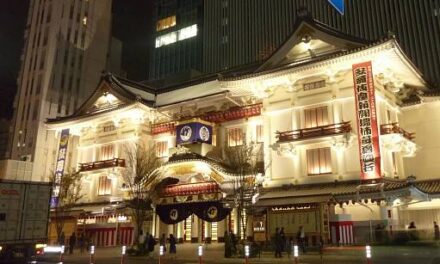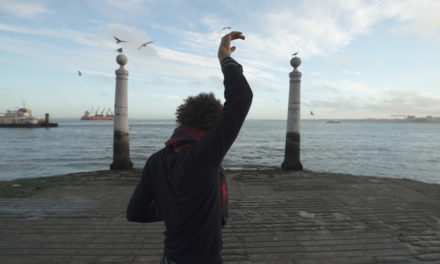During summer, the Flemish theatre lover catches up on what he missed during the season. And the amateur sociologist that I am—sometimes—observes that the audience of the Flemish summer festivals Theater aan Zee (Ostend) and Het Theaterfestival (Antwerp) seems to correspond much less to the inner circle of theatre lovers than the audience during the season. Sometimes you have the impression, through the regular season, that theatre is mainly made for other theatre-makers, but at these festivals, hundreds of pure lovers, of all ages, show up. At the same time, the after-parties at these festivals are gaining importance as the very meeting place for the inner circle of the usual suspects. You’d wish that the summer never ended, that the festival never ended. Performing arts, so I believe, could profit from this paradox. In any case, you’d like to believe so, in spite of this ‘summer of intolerance,’ in 2016.
Setting aside Jan Fabre’s 24-hour performance Mount Olympus, the summit of endurance at Het Theaterfestival was reached by the performance of Borgen, a 9-hour adaptation of the Danish television series about the coulisses of politics and a prestige project of the Noord Nederlands Toneel (Groningen), directed by Ola Mafaalani. Tickets are expensive; there are no free tickets or reductions, not even for press and the in-crowd. But you are given the opportunity to see a visually and dramatically enchanting spectacle, including exquisite gastronomy. It’s theatre for the moderately critical middle-class, and it feels slightly uneasy when it becomes so obvious. In the original series by Adam Price, the balance between political content and personal narrative—how to reconcile responsible parenthood and an exciting marriage with endless political overtime?—is well preserved. However, in the theatrical version, this balance is toppled more than once. All aspects related to family life receive more attention; political themes are treated more quickly and more superficially. Only after some time does the substantive plus-value of such an adaptation for the theatre become apparent.
In a mainstream series such as Borgen, private stories are forced into the style of a soap, albeit perhaps a bit more sophisticated. But live theatre doesn’t suffer from the implicit compulsion of the sentimental realism that most of the time takes place in a kitchen. The lonely toddler and the depressive teenager—the children of Birgitte Nyborg, the fictive Danish prime minister and the main character (a role by Malou Gorter)—cross the stage during political discussions in antechambers; they disturb press briefings without consequences. Their elementary theatrical presence influences the image, just like the presence of Bent Sejro (Wim van der Grijn), Nyborg’s mentor, does. After his stroke, you observe his slow but steady revalidation, as he shuffles over the stage until he can walk without his cane. The scenography is layered—a balcony, a wide staircase on the background, three concentric round tables, often descending from the flytower, together or one by one—and the soundscape, performed live by the Eef van Breen Group, is all-embracing, lightly jazzy, but never too ‘loungy.’ Through these elements, the stage seems to lose all its political ramifications, and the subtle political details vanish altogether.
However, this comprehensive ‘depoliticization’ disappears in the subsequent episodes dealing with issues of refugees and migrants (the Syrian background of director Ola Mafaalani might have played a role in this choice). The right-wing populist Svend Aga Saltum (Harry Piekema) is not a caricature of his Dutch colleague Geert Wilders, but he behaves mostly as a reasonable and civilized man. His interventions contrast sharply with the political games the partners of the governmental coalition inevitably play: this is an audacious dramaturgical choice, faultlessly performed. Nyborg’s replies—especially in an emotional speech—are remarkably ‘un-political’; they are a humanist answer to the coarseness of the contemporary political discourse, especially in the Netherlands. This Borgen is theatre for the civilized intellectual, who nods approvingly at this dose of healthy moralism, about which one should not be ironic. However, in Mafaalani’s hands the apotheosis of the story, which almost comes down to the canonization or the Assumption of the Holy Virgin called Birgitte Nyborg, it is over the top. As a spectator, though, I suppress this grandiloquence rather easily.
The price of the ticket keeps a younger audience away from this Borgen, but elsewhere at these festivals they watch and listen eagerly. They are massively present at performances such as De radicalisering van Sadhettin K. (‘The radicalization of Sadhettin K.’), during which the eponymous actor/director relativizes himself to death as a depressive stand-up comedian. After a series of productions in which he tried too hard (as he confesses himself), but quite successfully, to express the inner divisions of a Dutch Turk (or a Turkish Dutchman), including the disproportionate attention to religious identity, he takes stock of the situation, the whole enterprise having ended up in red figures. Getting no further than some half-racist jokes, he concludes that he will always stay ‘the other,’ the dangerous other even, and that he would be better off shutting his mouth and beginning to sell irony. No more festive stage set here, but the debris of his previous sets transformed into a cardboard tank—a tank he has stopped himself, maybe, at the Bosporus Bridge in Istanbul, on that infamous 15th of July. “Radicalization means impotence” seems to be his message, not just the impotence of the theatre maker whose work is easily marketable as ‘migrant art,’ but even more the impotence of the spectator, who suddenly sees that his own ‘modest’ racism is being absolutized in an angry Turk.
But not only Sadhettin Kirmiziyüz is angry; so is Lucas De Man, who plays out his democratic anger in the monologue De Man door Europa (‘De Man through Europe’), also quoting his name in his title. He reports on his journey through Europe, from Helsinki to Istanbul, where he had conversations with intellectuals about the future of democracy in Europe. This adventure results in an entertaining performance, with smart talks between a live actor and talking heads on screens, with a dynamic map using Playmobil puppets (Sadhettin K. used a similar device as he drew the history of the Mediterranean with white sand), and with half-hearted answers on multiple questions about participative democracy in the age of the Internet. Lucas De Man touches upon important issues, about the (open or closed) borders of the continent, about the active responsibility of (theatre) artists, but he—or his interviewees?—reinvents the wheel over and over. Gramsci’s famous quote—‘pessimism of reason, optimism of the will’—is paraphrased endlessly, until it loses all its meaning; the so-called revolutionary potential of so-called social media is weakly reaffirmed. Plenty of well-meant energy, plenty of vulnerable intelligence, but pretty modest eloquence.
Het Theaterfestival is a curated festival: a jury of connoisseurs selects the most important productions of the last season. Traditionally, it opens with a ‘state of the union.’ Wouter Hillaert, a theatre journalist and also spokesman for the citizens’ movement Hart boven hard (‘Heart above hard’), observed that there is little ‘union’ in the theatre world, that most of the organizations breathed a sigh of relief when they were informed that the most recent (re)distribution of subsidies by the Flemish government would not cause them too much harm. Along the same lines, Hillaert could do nothing other than observe little to no compassion for the less fortunate organizations—mostly smaller troupes—sacrificed by the center-right government led by the Flemish nationalist Geert Bourgeois, who seems to have favored in its decision grand-scale prestige rather than grassroots initiatives. During the eighties, Hillaert remarked, the (theatre) artist conquered radical autonomy: today almost everything seems to be allowed in a present-day official theatre, as long it stays on stage. However, the institutions and the relations of production—to use Marx’s terms—have not developed along the same lines.
These institutions continued to function as apparatuses which focus primarily, to use the same vocabulary, on the exchange-value of things (audience statistics, international co-producers, . . .) rather than on their use-value. The nice rhetoric suggesting the opposite cannot hide this fundamental contradiction. After Hillaert’s speech, some members of this generation of the eighties, a decade in which Flemish theatre took indeed a different course, went to their typewriters, suddenly filling the op-eds of quality newspapers to assert, rightly so and contrary to what Hillaert seemed to suggest in his speech, that some artists had indeed been able to transform their artistic credos into different forms of organization and production (Jan Fabre’s Troubleyn or Anne Teresa De Keersmaeker’s Rosas being the most evident examples of this transformation). Unfortunately, the debate raised by Hillaert ended up circling around in the inner circle of subsidized artists, despite its larger ambitions, without making any serious political waves. A foreign guest of the festival remarked that there were no TV cameras present when Hillaert read out his speech and that the whole debate was doomed to stir nothing more than a few ripples in the cultural pool, without ever having any impact within the political realm. And indeed, the caravan went by, even when the new rector of the University of Antwerp, historian Herman Van Goethem, impassionately read, quite surprisingly in his position, a manifesto against the excesses of meritocracy, as the opening gesture of a would-be politicized Theaterfestival.
Members of the ruling coalition present in the audience could easily turn their heads, because all this rhetoric originated, as usual, so they would say, from the same politically correct clique. But then they would be unable to discern that the real battle fought on stage was one of one generation against the other, the political tastes of a younger generation as opposed to a mainstream establishment that has completely interiorized the values and discourse of the avant-garde. An irony was maximized—as irony is, by definition, harmless—in the performance of Beckett Boulevard, that same night, by Compagnie De Koe. The actors tried to turn a thought experiment into theatre: what if the female actor on stage really decides to go into politics, what if the male actor really starts to serve society as an obtrusive waiter? Can you turn such a reversal into a theatrical performance, or is this double deception? Self-deception and deception of the spectator who is taken to believe that he watches real people on stage? The reflections proposed by De Koe in this play were all typically post-modernist exercises of thought, vintage eighties. Politically relevant, aesthetically relevant, psychologically subversive, but also quite comfortable, precisely because of this irony. And with hindsight, it seemed as if the discourse against over-aged ‘new aesthetics’—as the style of the eighties was sometimes labeled—and their alleged complacency, in Hillaert’s ‘state of the union,’ had fallen on a cold stone.
And so we arrive at a fundamental question: is contemporary theatre going up a dead-end street, with its pretension of intellectual plus-value? It isn’t, but this plus-value is seldom visible in attempts at generalization, on a bigger (Borgen) or on a smaller (De Man door Europa) scale. A particular, more specific perspective seems to be more effective, as was shown this summer, in Antwerp and Ostend. Let me give a couple of examples of what I mean by this. In Helpdesk the Rotterdam-based collective Wunderbaum mercilessly deconstructs the claim of flexibility that a certain idea of progress forces upon all of us. In an empty office space, looking down on the austere skyline of Antwerp, Wine Dierickx, with a headset and lots of faux fur as the only props, takes us to a call-center which pretends to offer solutions for literally every kind of problem, including the advice to erase oneself. The audience listens with a headphone, an effect creating distance but also closeness to her voice.
Lucinda Ra, another collective with the twin sisters Stefanie and Barbara Claes as central members, have created a genre in its own right, so it seems, some sort of unique ‘militant absurdism.’ In Euthanasie met Barbara en Stefanie (‘Euthanasia with Barbara and Stefanie’) the sisters stage an anecdotic bereavement, speaking of death and awkwardly dancing with an old man in his underwear, with gigantic puppets made from recycled garbage and with a dervish. Together they recount a family history, incoherent but exactly because of that remarkably lively, as they turn, for minutes at a time, around their axes, just a dervishes do: literally dizzying. The sisters’ bone-dry story about the farewell to another (but also about our own farewell necessarily pending above our heads) silences the spectator with some sort of strange melancholy. Another particular story, that is nevertheless far more direct and even aggressive than the other example, is Samira Elagoz’s monologue Cock, Cock . . . Who’s There? Elagoz is half-Finnish, half-Arabic, and she sublimates her own rape in an artistic research project. Live on stage, soberly attired, her hair in braids, glasses on her nose, she moves in a highly controlled way. She describes herself as a ‘bitch,’ as a heavily made-up seductress who tracks men on dating sites and excites them. Until she gets raped again: then she takes stock, completely burned out.
At the beginning of the performance, she lucidly explains that she filmed her own experiment to come to a better understanding of the structural impotence, especially in the dark grey zone between sexual lust and violence, of women in front of men: in every erotic innuendo rape lies in wait—always her rape, never his. He, man, chooses to be a perpetrator; she, woman, never chooses to be a victim. This might sound like a sharp provocation, but Samira Elagoz does not exploit the privileged position of the commentator she creates on stage. In spite of the cruelty of the fabricated document (is it a guilt-ridden masculine idea to think this could be fiction in a documentary form?) she manages to give voice to this impotence, whatever shape it might take, and to communicate all post-factum reflections and feelings (cynicism, anger, verbal aggression, sentimentality) in a really theatrical way. And yes, maybe, Cock, Cock . . . Who’s There? is too much an explanation of a report, not enough dialogue or debate between the multiple versions of herself performed by Elagoz herself. And yes, maybe her performance is not politically rigorous enough, as it is. But, quite paradoxically, in its directness, in its focus on a particular case or story, Elagoz’s performance reveals itself to be far more political than the explicit theatrical commentaries that approach history and politics from a more general perspective, whether the approach is highly dramatic (Borgen) or lightheartedly philosophical (De Man door Europa).
As a critic, writer and dramaturg, Klaas Tindemans lectures in dramaturgy and cultural studies at RITCS | School of Arts. He also coordinates all scientific and artistic research conducted at this same art school.
This post was written by the author in their personal capacity.The opinions expressed in this article are the author’s own and do not reflect the view of The Theatre Times, their staff or collaborators.
This post was written by Klaas Tindemans.
The views expressed here belong to the author and do not necessarily reflect our views and opinions.

